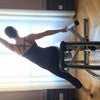Description
About This Video
Transcript
Read Full Transcript
Hi, I'm Karen and I'm here today with a tutorial on east centric contractions and east centric loading. I have a couple of exercises that I'm going to demonstrate with some explanations and then you can take the concept and run with it from there. First we have to remember that East centric is a loading contraction against resistance where the muscle is actually elongating even if it's at a slow speed or a little bit quicker speed. The most common place where we typically see an east Cedric contraction is when we start our roll back from the city, from the, from the seated position, excuse me, so the arms are out front and we start to roll back. We understand this completely as the pelvic area rolling backwards, the abdominals e long gating underneath the resistance of gravity.
That's a very common exercise in east centric loading. So I'm going to move on now to a different part of the spine in the neck. And you've may have seen some of these exercise. I've done them before in a mat class, but I just want to paint a different picture here. So I'm going to [inaudible] prop myself up on this mat and make sure my head is propped up accordingly.
I'm just going to put this ball under my chin so that I make an awareness of where my deep neck flexors come in. Now I don't have any trouble lifting my chin and curling my spine, so as I hold this, I'm going to take the ball out. That's my marker. Now as I hold myself here, I am now in an isometric contraction, but as I unroll myself back down slowly, I'm actually he long gating the front of my neck as I come all the way down. It's not uncommon for clients to say that their neck is doing a lot of the work. Some times the neck has to work.
So here's how we get an east centric load to the deep neck flexor. I'm going to take the ball, I'm going to hold the ball gently. Then I'm going to use one of my hands and I'm going to help my own head to lift up. I still keep my awareness here of my trunk and I hold right here. I'm going to take the ball out because I don't want to over squeeze it.
And now I'm going to hold my head with my hand in this position and I'm going to teach my client or myself to let go of this hand. And then again, slowly he long gate down to pause. I'm going to show you what it might look like when we have a challenge. So I'm going to hold the ball for a placer or a spacer. If you, oh, I'm going to curl my trunk and now I'm getting into my rib curl. Like I'm preparing for the a hundred beats and we know that to take the drag off our superficial that we actually have to be able to curl up enough here.
So what happens to people now? Oh they start getting tired and then their face starts to go up like this. And then that's all superficial neck holdings. When we got to reposition, regroup, hold, hold. And then he long gate down.
And what I mean is not change the shape of that until it's all the way down. So again, it's an east centric loading of the front of the neck, much like in the front of our abdominals when we roll back. So taking this one final step further, you can see how it's so important in this roll back to understand the up and over connection of the ribs to the neck on the shoulders. So that right here on east centric, Lee abdominals and east centric Lee deep neck. Okay. So that's a concept to play with.
And in the long run it actually helps, uh, with some neck and children is comfort. So let's move on now and we'll do just a couple other ones that I think are so important that sometimes get misunderstood. So this one is for your serratus. And so in this particular exercise I have this spring here, it's a yellow spring about shoulder height. So we know the exercise that we call the hug a tree and salute and all that.
So I'm going to give myself enough movement forward and I'm actually going to stabilize myself with my hand because right now I'm not going for the true exercise of hug a tree in salute. But what I want to create is this. I'm going to hold myself here to stay stable, tighten up my thighs, curl my toes to make that connection. I'm going to take my arm and horizontally a d, duct it to the mid line. Now I'm going to use my serratus anterior to protract my scapula. That's work. Now as I resist my spring coming back, that's an east centric load of my serratus and then I'm going to hold that as my arm comes back to the starting position and then rest down.
Oftentimes what happens in this exercise is we don't always make the commitment, if you will, or the decision to do I want to move just my arm or do I want to move my blade with my arm or do I want to move my spine? We get caught up in wondering why it is that we want to move. So I'm going to make the decision here and I'm going to give myself a little more challenge. So I'm going to come forward and to keep my line, keep my height, keep my relationship in, check from my ribs all the way down to my pelvis. I am not going to use my arm this time to stabilize me.
I'm going to horizontally a d duck. This is tough. Now I'm going to protract my arm, not directly in front of me and not directly out to the side, but somewhere that we call scaption. Some of you know that word, some not. All that means is that you're not fully in front there, fully out to the side. And then now I'm going to resist that spring back and then return. I hope you can see that.
What I'm going to show you now is what happens if it doesn't happen correctly. I pull, I reach snap and down pull. Can't find out what exactly it is that I'm looking for. So play with the body position, play with the position of the spring to ask for the protraction. You could also do this same exercise. Um, spring loaded from the bottom and the tower right.
And you know that as a shoulder blade, like a puppet arm up and down. So you can create that as well. So as we understand the position of the shoulder blades and we understand the job of the serratus as a protractor, now we'll take this into another exercise where we kind of lengthen our body in this neutral position. Much like when we do round box, excuse me, round back on the short box or hinge back on the short box. So now I'm just going to go forward in a hinge. I'm going to leave this ball here because I'm gonna use it in a second and you'll see why I'm going to curl my toes under to set myself up.
Arms are out long as my arms go out. In a way they're actually going into a little bit of protraction because my arms are past 90 degrees. As I hold this position, you can hear in my voice that I'm a little quiver, he and then I'll bring myself all the way back. Oftentimes in this shape when we have a little weakness in the neck because the neck doesn't understand how to hold against that force, we may not be able to go out as far. But if I just gently look down, stick the tongue on the roof of my mouth, I can almost go out further because I'm keeping everything in check. So again, this might be what it looks like in a person that can't keep their neck and alignment and then their head just lifts a little bit. Then their back starts to sag and then they try to correct everything while they're already out there, when it's actually a lot safer to the spine to make the efficient set up be the action of the exercise.
So don't try to correct that particular when you're already way out there last time. Okay, so that's a really good exercise there. So the last one I want to show you, I like this because a everybody lately, right, is all up in the air all about the role of the Gluteus medius and the maximus and all these muscles. Actually I have two more. I'm gonna do one more with the spring and do one more free form, meaning without any prompts. I'm going to put this spring, first of all, I have my little flap up on the Cadillac to protect it and to go ahead and lie myself down. And I'm going to give myself enough tension on the spring that I'm in an ie long gated position here.
But one thing I'm going to do that's kind of interesting is I want to cut myself some slack in my spine. And what I mean by that is I'm not going to hold, so lengthen it in a drop position. So I'm actually going to let myself have a little bit of flection. I'm going to give my back a little bit of break so that I can get more work in my hip. And this is where my action can be. So as I lift this leg up quick and I let it go, slow, slow, slow, quick up, slow, slow, slow, not gonna use my waistline. That's elongated. I use the side of my hip up quick and then I resist that spring, you know, from pulling me down. So again, lift and then lower, lower, lower. I'm going to arrest a second cause that's already tired.
But what I want to go over one more time is I'm going to cut my spine some slack on purpose as a choice. It's not that I want you all to do your leg kick series all rolled up like this, but I want you to understand that every once in awhile to give the client some slack or the bodies in slack. I just kind of rest a little bit like this. So I still scoop in my belly. I still feel this awareness, but now I maximize my awareness in my hip because I'm not thinking so hard to manage the rest of my body. I mean, I will go back and and regroup of course and get people into ideal postural connections. But that's just a nice way to let somebody get a little bit of action into the side of the hip. And then one of the final, or the final exercise that I want to go over again as an ecentric load.
And you've seen this in tons and tons of exercises. Well, maybe not tons. Okay. Maybe three or four. But it's a curtsy. Okay. So as we curtsy, I'm going to step to the side first. I'm gonna take my left leg behind me and I'm going to hang on. Okay. I can have a pole or a foam roller something, but I'm going to go ahead and get down into this curtsy position. And right here it's my left side of my torso that has e longing.
So this is the work on this hip. So if I take away my arm, that's one challenge. If I take away my back leg, that's another challenge. And then I bring myself back up. I'm gonna do it again from the front. So as I take this leg and bring it way back behind me, and I keep this foot down, it can help me as much as it needs to. And then I can push myself up. And then as I curtsy now I'm going to try to not touch it.
I'm going to see how low I can go to load the side of my hip and then bring it back up. Whew. Just that little bit. It's kind of challenging. So I hope you enjoyed this quick tutorial on east centric lengthening, and I bet that you can probably figure out a lot of other exercises that piles uses that way because there are a lot of them. But again, I just wanted to bring some of them to life for you. So thanks for joining me for this tutorial.
Comments
You need to be a subscriber to post a comment.
Please Log In or Create an Account to start your free trial.





















